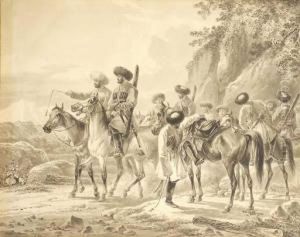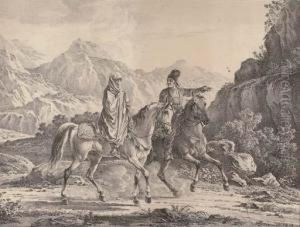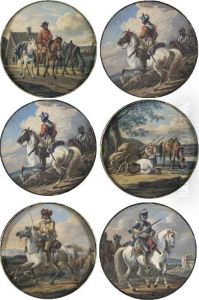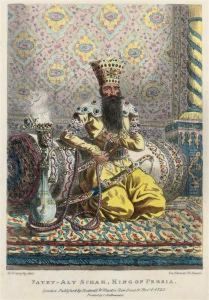Aleksandr Osipovich Orlovski Paintings
Aleksandr Osipovich Orlovski was a prominent Polish-Russian artist, known for his significant contributions to painting, graphic art, and illustration in the late 18th and early 19th centuries. Born in 1777 in Warsaw, which was then part of the Polish-Lithuanian Commonwealth and later became part of the Russian Empire, Orlovski's artistic journey began in his early years, and he quickly emerged as a talented artist in the European art scene. His works are characterized by a keen observation of social life, military themes, and a vivid representation of the customs and costumes of his time, capturing the spirit and transformation of the era he lived in.
Orlovski's education and artistic training took place in several key cultural centers across Europe. He studied art under renowned artists and in prestigious institutions, which significantly influenced his style and technique. His talent was recognized early on, and he gained patronage that allowed him to travel and work across Europe, including stays in Paris and Saint Petersburg. In these cities, Orlovski was exposed to the vibrant artistic movements of the time, assimilating various influences into his own unique style.
In the early 19th century, Orlovski settled in Russia, where he became particularly known for his illustrations and graphic works. He contributed to the visual culture of the Russian Empire, portraying scenes of everyday life, military subjects, and historical events with a mix of realism and romanticism. His illustrations often accompanied texts, bringing stories and characters to life with his detailed and dynamic compositions. Orlovski's works not only reflect his artistic skills but also provide a valuable visual documentation of the period's social and cultural life.
Throughout his career, Orlovski was celebrated for his ability to capture the essence of his subjects with both humor and gravity. His military and battle scenes are particularly noted for their dynamism, accuracy, and the way they convey the tumult and valor of the era's conflicts. Despite the challenges of working in a turbulent period marked by political changes and wars, Orlovski maintained a prolific output, contributing to various publications and projects.
Aleksandr Osipovich Orlovski passed away in 1832 in Saint Petersburg, leaving behind a rich legacy of works that continue to be studied and admired. His contributions to art are remembered for their historical significance, artistic merit, and the unique insight they provide into the life and times of the early 19th century in Russia and Poland. Orlovski's ability to blend realism with elements of romanticism, along with his detailed depiction of uniforms, costumes, and landscapes, has secured his place in the annals of art history as a distinguished artist of his time.



